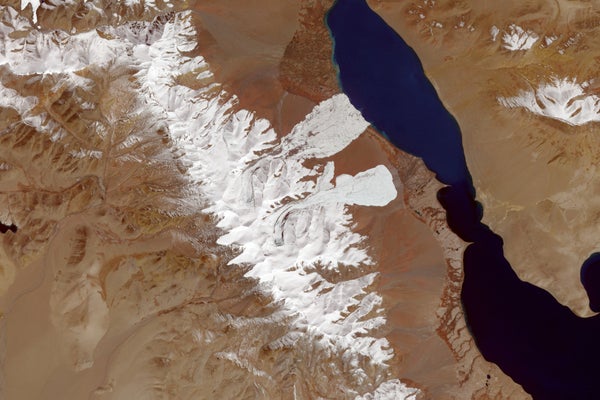In July 2016, a glacier in Tibet's Aru mountain range suddenly and catastrophically collapsed. The resulting ice avalanche buried more than 3 square miles of land, killing nine people and hundreds of livestock.
Just a few months later, a second glacier in the same mountain range also unexpectedly collapsed.
In the years since, scientists have worked to understand what caused the twin avalanches. They found, in a study published in 2018 in Nature Geoscience, that climate change is at least partly to blame.
On supporting science journalism
If you're enjoying this article, consider supporting our award-winning journalism by subscribing. By purchasing a subscription you are helping to ensure the future of impactful stories about the discoveries and ideas shaping our world today.
And now, research suggests the consequences are still rippling today.
A pair of mountain lakes, situated just down the mountainside, took a hefty blow when the two glaciers collapsed. In each case, a deluge of ice rumbled toward the water.
In the years since, as the ice has slowly melted, it's caused one of the lakes to rapidly expand. If it keeps growing, scientists say, the two bodies of water could merge into a giant super-lake — dramatically reshaping the landscape, altering the local ecology and potentially increasing the risk of flooding.
It's a reminder that the repercussions of climate disasters aren't always immediate. Sometimes, they reverberate for years on end.
The findings, published last month in the journal The Cryosphere, are the product of several years of monitoring in the aftermath of the two avalanches.
Shortly after the second Aru glacier collapsed, an international team of scientists, led by Yanbin Lei of the Chinese Academy of Sciences, set up equipment to monitor the water levels at the two nearby lakes, dubbed Aru Co and Memar Co. In the following years, they conducted additional on-site surveys to explore the ways the landscape had changed.
They also analyzed satellite data, which helped them detect changes in the size of the lakes.
They found that the two avalanches had a substantial impact on the landscape.
The first avalanche sent more than 7 million cubic meters of ice — the equivalent of nearly 3,000 Olympic-size swimming pools — directly into the Aru Co lake. The ice hit the water with such force that it physically altered the lake's shoreline.
In the aftermath of the two avalanches, melting ice cooled both lakes by several degrees.
Perhaps most ominously, the meltwater appears to have caused the Memar Co lake to swell. Between 2016 and 2019, the scientists found that its water levels rose by more than 2.5 feet each year.
The researchers believe Aru Co's water levels were less affected because it's an outflow lake — water that goes into the lake tends to flow out into nearby rivers, with some of the overflow eventually winding up in Memar Co.
Memar Co was already growing before the avalanches struck, although at a smaller rate. Scientists believe climate change is to blame for that, as well. As the region has warmed, it's also grown wetter, and the extra rain has caused lakes all across the Tibetan Plateau to grow.
But the collapsing glaciers gave Memar Co a significant boost. The new study suggests that its growth after 2016 was about 30% faster than it was in the years prior.
Overall, the research suggests that the avalanches contributed to nearly a quarter of Memar Co's growth since 2016. And it may not stop there.
The ice from the first avalanche had mostly melted by the summer of 2018. But the second avalanche may still be lingering on the landscape. As of a year ago, when the scientists surveyed the area, they found that nearly a third of the ice it dropped still had not melted.
That means more meltwater may still be coming. That's on top of the growing rainfall driven by climate change.
If Memar Co keeps expanding, it could merge with Aru Co within the next decade.
That could have widespread consequences, both for human communities and for the natural ecosystem, the study warns. In other parts of the Tibetan Plateau, expanding lakes have caused problems with flooding, inundating roads and other infrastructure.
At the same time, Aru Co and Memar Co aren't identical ecosystems. Memar Co is a much saltier lake, meaning they don't necessarily support the same kinds of organisms. It's unclear how the two habitats might change — and how they might affect the wildlife that depends on them — if they were to merge.
"A scenario like that could significantly change the regional landscape and disrupt local ecosystems," study co-author Tandong Yao of the Chinese Academy of Sciences said in a statement. "That's why we need to watch the two lakes more closely in case of such changes."
Reprinted from E&E News with permission from POLITICO, LLC. Copyright 2021. E&E News provides essential news for energy and environment professionals.
